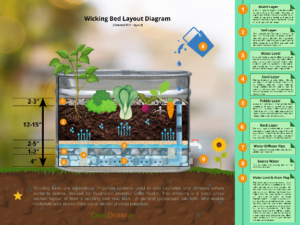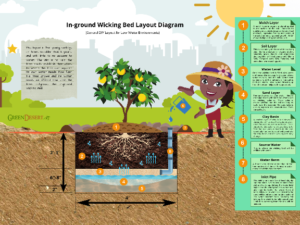What is a wicking bed and why do I want one?
Let’s start with the why. Wicking beds have tons of benefits that we’ll discuss but the one that matters most is wicking beds are water efficient, practically self-watering planting beds. And in a time when water is scarce and growing food is becoming more popular, every conservation method counts.
So let’s talk about how wicking beds work to understand why they are so crucial, especially in warm climates… and then we will show a layout to help you build your own.
A wicking bed is a fully contained, self-watering planting bed that basically has a built-in reservoir that supplies water from the bottom up. It uses capillary action to water the plants, the process where water flowing in narrow spaces is pulled upward by molecular forces against gravity. It’s the same force that you see when you dip a paper towel into a cup of water and watch the water climb up the paper. That’s the wicking happening before your eyes. And it happens in many materials including soil and gravel – just two of the ingredients you’ll need for your wicking bed.
I know, it seems odd that water is moving up, against gravity. But it works. Just think about that paper towel in your garden bed. As water is wicked up within the soil the plant’s roots receive water and nutrients from within the soil.
More benefits:
- Less evaporation!
One of the things that make wicking beds water-efficient is since you’re watering from the bottom up, you prevent some evaporation of surface water. So that conserves water and it also helps your plants thrive because when you water from the top you risk accumulating salts and minerals being left behind in your soil from evaporation.
- Less maintenance, convenience!
Wicking beds can be designed where you only have to refill with water once per month, giving you flexibility. And you don’t have to worry about weeding.
- Less fertilizer needed!
As the water wicks up in your wicking bed, it carries dissolved minerals, feeding your plants. Since it’s a closed system, there is very little nutrient loss because the nutrients in the soil are not flushed out through the process of watering as in traditional gardening.
Wicking beds do have some disadvantages:
- They cost more to install than standard raised beds or in-ground gardens
- Most plants like soil dry/wet cycles, wicking beds are constantly moist so it may not be appropriate for all plants
- Moisture height is dependent on the water reservoir level. Based on this height will determine how high the water wicks up.
- They will freeze sooner than in-ground wicking beds in the fall.
Below is a diagram of how our wicking bed is designed. There is no one best way to lay out a wicking bed; it all depends on what you are growing. The below design is laid out for tomatoes, ginger, potatoes and leafy greens. Use our layout as a basis and a starting place for your design. Maintenace on our system is draining and refilling the bed once per year.
Want to build your own wicking bed? Check out our detailed diagrams here.
In-ground wicking beds serve as training wheels for trees in low water environments. The wicking bed helps slow water down in order for wicking to feed the tree. The in-ground wicking bed will only help the tree establish its root system but may not be enough to provide for the tree indefinitely. Depending on how the in-ground bed is designed will dictate how long the bed will be efficient. Our layout will likely help a tree for about 2-3 years. Larger in-ground wicking beds could be made for longer periods if needed.
Want to build your own in-ground wicking bed? Check out our detailed diagrams here.






